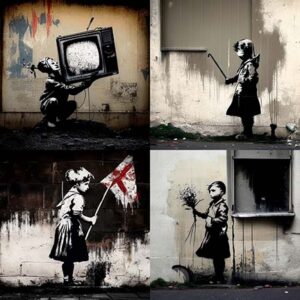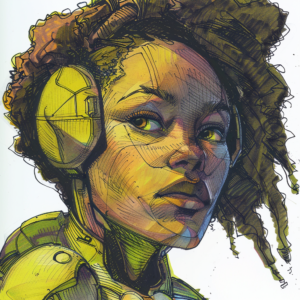 Thanks to AI image generators such as Midjourney and Dall E of Open AI it is easy to rapidly create images almost as fast as you can type in a prompt. This has led some to speculate that this will put artists out of work and perhaps even be the doom of creativity.
Thanks to AI image generators such as Midjourney and Dall E of Open AI it is easy to rapidly create images almost as fast as you can type in a prompt. This has led some to speculate that this will put artists out of work and perhaps even be the doom of creativity.
In addition to being a philosophy professor, I also create stuff for tabletop role playing games like D&D and Call of Cthulhu. In addition to writing, I also create maps and images. As such, I do have a stake in the AI game and disclose this as a potential biasing factor.
Looking back into the shallow depths of human history, professions are changed or even eliminated by economic and technological shifts. Fads in fashion or food can result in significant economic changes, such as the case of the beaver pelts once used in men’s hats. Once a lucrative market and source of income, the fashion trend ended, the trappers had to find other options. In other cases, the change technological. For example, New England was known for its whaling industry and whale oil was used extensively for lighting. When alternatives, such as kerosene, became available, this whaling industry ended. Kerosene was itself mostly replaced by electricity, also resulting in changes in employment. And, of course, there is the specific technological change of automation, when machines reduce or eliminate the need for human workers.
For most of human history, machines tended to impact physical jobs—although there is the example that electronic computers eliminated the need for human computers. Back in the 1980s when I first debated about AI as an undergraduate, most people thought that AI would not be able to engage in creative activity. This was often based on the view that machines would never be able to feel (which was assumed to be critical for creativity) or that there is some special human trait of creativity a machine could never replicate. As a practical matter, this seemed to hold true until AI started producing images and text good enough to pass as created by competent humans. This has led to the practical worry that AI will put creatives out of work. After all, if a business can get text and images created by AI for a fraction of what it would cost to pay a human, a sensible business will turn to AI to maximize profit.
This shows that the true problem is not AI but our economic system. A sci-fi dream has been that automation should be used to free us so we can spend more time doing what we want to do, rather than needing to grind just to survive. But AI used in this manner would free people from employment opportunities.
While a creative might like creating to earn the money they need to afford food and shelter, they are creating primarily for economic reasons and usually not doing what they really enjoy. I distinguish between people who make some income from their creative hobby (as I do) and people who must create to earn their living. While someone who depends on creating to live might enjoy their work, AI is only a problem if they need to create to pay the bills. After all, if they were creating out of the love of creativity, to express themselves, or out of pure enjoyment, then AI would be irrelevant. They would still get that even if AI took all the creative jobs. Since I do not depend on my game creations for my living, I will keep creating even if AI completely dominates the field. But if AI replaces me as a professor, I will keep doing philosophy but I will need to find new employment since I have grown accustomed to living in a house and having food to eat.
As such, the problem with AI putting people out of work is not an AI problem but a problem with our economic system. Part of this is that creative works are often mere economic products. It just so happens that the new automation threatens writers and artists rather than factory workers. But this threat is not the same for all people.
I titled this essay “AI: I Want a Banksy vs I Want a Picture of a Dragon” because of the distinction between the two wants and its relevance to AI images (and text). Suppose I want a work by Banksy to add to my collection. In that case, no AI art will suffice since only Banksy can create a Banksy. An AI could create a forgery of a Banksy, just as skilled human forger could—but neither creation would be a Banksy. While such a forgery might fool someone into buying it, as soon as the forgery was exposed, the work would become valueless to me—after all, what I want is a Banksy.
When people want a work by a specific creator, the content is of far less importance than the causal chain—they want it because of who created it, not because of what it looks like, what it sounds like, or what the text might be. One example that nicely illustrates this is when Harry Potter series author J.K. Rowling wrote a book under a pseudonym. Before the true authorship was revealed, the book sold few copies. After the reveal, it became a top seller. The exposure of a forgery also shows this. A work can be greatly valued as, say, a painting by Picasso, until it is revealed as a worthless forgery. Nothing about the painting itself has changed, what has changed is the belief in who created it. In these cases, it is the creator and not the qualities of the work that matters. As such, creatives whose work is sought and bought because it was created by them have little to fear from AI, aside from the usual concerns about forgeries. But what if I just want a picture of a dragon for my D&D adventure? Then AI does change the situation.
Before AI became good at creating images, if I wanted a picture of a dragon, I would need to get one from a human artist or create it myself. Now I can just go to Midjourney, type in a prompt and pick between the generated images. I can even direct the AI to create it in a specific style—making it like the work of a known artist. As such, while AI is not (yet) a threat to creators whose works are sought and bought because they created it, it is a threat to the “working class” of creators who sell their work to those who are seeking a specific work rather than a work by a specific person. AI is a real threat to them, but a real boon to those who want works for the lowest price and want them quickly. AI is also a threat to those who might have been the next Banksy. If artists cannot earn a living while they work towards the fame that makes their works desirable because they are their work, then there will be fewer such artists. Of course, the value of such works is also largely a result of features of our economic system—but that is a matter way beyond AI and art.
In closing, creators like Rowling and Banksy will be just fine for now, but the “working class” creators will be facing increasing challenges from AI. This obviously should not be blamed on AI, but on those who create and perpetuate a system that allows people to inflict such harm on others just because they become less economically useful to the business class. The heart of the problem is that creative works are a commodity and that some people insist that others must labor for their profit—and ensure that violence is always ready to maintain this order.

 Being nerdtastic by nature, my nerd sense picks up disturbances in nerd culture. One of the loudest types of disturbances is when people express outrage at gender and race swapping involving established characters.
Being nerdtastic by nature, my nerd sense picks up disturbances in nerd culture. One of the loudest types of disturbances is when people express outrage at gender and race swapping involving established characters.